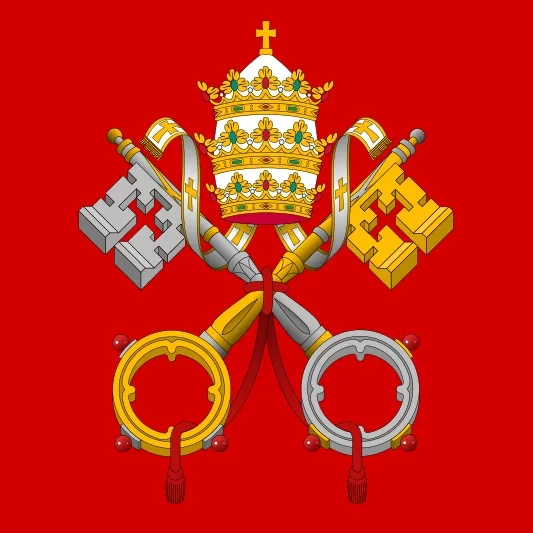The purported skull of St. Thomas Aquinas in the Italian town of Priverno. / Credit: Daniel Ibanez/CNA
Rome Newsroom, Mar 7, 2024 / 14:00 pm (CNA).
On the eve of the 750th anniversary of St. Thomas Aquinas’ death, a skull revered as a relic of St. Thomas Aquinas was carried in a solemn procession through the cobblestone streets of the southern Italian town of Priverno.
Bishop Mariano Crociata led the procession to honor the medieval philosopher and theologian widely considered one of the greatest thinkers in Western civilization who died in the nearby Fossanova Abbey on March 7, 1274.
The procession of the purported skull of St. Thomas Aquinas in Priverno, Italy, March 7, 2024. Credit: Daniel Ibanez/CNA
The relic has been venerated in the town’s 12th-century cathedral since it was found in the altar of nearby Fossanova Abbey in 1585 with notarized documents indicating that it was the skull of the Angelic Doctor.
Father Alessandro Trani, the rector of the Priverno Co-cathedral of Santa Maria Annuziata, says that the strong devotion in the town, which counts Aquinas as its patron, dates back centuries.
“Here St. Thomas spent the last days of his life,” Trani told CNA.
Father Alessandro Trani, the rector of the Priverno Co-cathedral of Santa Maria Annuziata. Credit: Daniel Ibanez/CNA
“[Aquinas] was staying with a cousin at the Castle of Maenza, and from there he asked to be taken to a sacred place and he was taken to Fossanova Abbey, where he ended his earthly pilgrimage.”
Aquinas died at the age of 48 in the abbey located about halfway between Naples and Rome after falling ill while on the way to attend the Council of Lyons.
Three months before he died, Aquinas experienced an intense revelation while offering Mass when he was nearly finished with his most significant work, the “Summa Theologiae” or “Summary of Theology.” After experiencing this revelation, Aquinas told his friend and secretary Brother Reginald of Priverno: “The end of my labors has come. All that I have written appears to be as so much straw after the things that have been revealed to me,” and he never wrote again.
Aquinas’ body was kept in Fossanova Abbey until 1369 when his relics were moved to Toulouse, France, where the Order of Preachers was founded and where Aquinas’ tomb can be venerated today in the Church of the Jacobins.
The skull in Priverno is one of two skulls currently claimed by Church officials as the skull of St. Thomas Aquinas. The Dominicans in Toulouse recently commissioned a new reliquary for the skull of St. Thomas Aquinas, which has been touring France and abroad.
A team of medical students and a neurosurgeon traveled to Priverno in 2023 to examine Italy’s putative relic of Aquinas’ skull for evidence as to whether he might have died from a traumatic brain injury and presented their findings at the American Association of Neurological Surgeons’ annual meeting.
The researchers are investigating the possibility of conducting a more in-depth forensic analysis of both skulls in Italy and France with permission of the local authorities to authenticate the relic.
Trani acknowledges that DNA analysis may one day help prove which is the true head of Aquinas but underlines that ultimately it is “the strong devotion of the people that through St. Thomas, as through every saint, brings a true, authentic encounter with God’s love.”
“St. Thomas speaks, has spoken, and continues to speak to my heart in the few months I have been pastor of this church,” he said.
Mass-goers honor St. Thomas Aquinas at the Priverno Co-cathedral of Santa Maria Annuziata on March 7, 2024. Credit: Daniel Ibanez/CNA
“St. Thomas was part of my formation … because he was one of and is one of the greatest doctors of the Church,” the priest added. “What fascinates me about Thomas is how he leads us into the depths of the mystery of God with the simplicity of a child who always knows how to wonder.”
The procession and celebrations of Aquinas in Priverno are part of two years of jubilee celebrations of St. Thomas Aquinas by the Order of Preachers.
During the jubilee year, Catholics can obtain a plenary indulgence by making a pilgrimage to a holy site connected to the Dominican order to either take part in the jubilee celebrations or “at least devote a suitable time to pious recollection,” concluding by praying the Lord’s Prayer, reciting the Creed, and invoking the intercession of the Blessed Virgin Mary and St. Thomas Aquinas.
The Dominican order’s double jubilee year will conclude after the feast of St. Thomas Aquinas on Jan. 28, 2025, the 800th anniversary of Aquinas’ birth. Aquinas was born in 1225 in the Italian town of Roccasecca, about 75 miles southeast of Rome, which at the time was part of the Kingdom of Sicily.
Bishop Crociata of Latina-Terracina-Sezze-Priverno led the procession in Priverno following Mass to honor Aquinas in a packed cathedral with standing room only. At the conclusion of the procession, the relic was transported to Fossanova Abbey in the front seat of a Jeep.
The purported skull of St. Thomas Aquinas is transported in a Jeep to Fossanova Abbey, March 7, 2024. Daniel Ibanez/CNA
Vatican Secretary of State Cardinal Pietro Parolin will offer Mass in the presence of the Priverno relic on March 7 in Fossanova Abbey, where a conference is also being held on Aquinas and the natural law sponsored by the Pontifical Academy for the Social Sciences.
Pope Francis sent a message to the academics participating in the conference to mark the 750th anniversary.
“The Angelic Doctor was profoundly convinced that since God is the truth and the light that illumines all understanding, there can be no ultimate contradiction between revealed truth and the truths discovered by reason,” the pope wrote.
“Central to his understanding of the relationship of faith and reason was his conviction of the power of God’s gift of grace to heal human nature weakened by sin and to elevate the mind through participation in God’s own knowledge and love, and thereby to enable us to understand and correctly order our lives as individuals and in society.”
“Here, Thomas points out, we see the heart of the Christian life as an act of priestly worship aimed at the glorification of God and the sanctification of our world,” he added.











